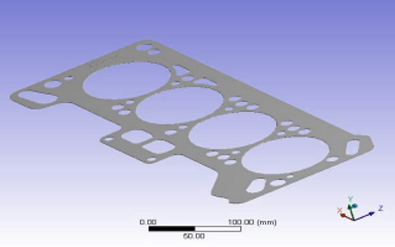
Now for this example, the solver is capable of handling the over-constraint because overall…the model is properly constrained. I don’t know exactly how the solver manages this, but I like to imagine it’s like two people fighting over who gets to keep a dog…and they place the dog in-between them and call for it, and whoever the dog goes to gets to keep it.
Cylindrical support ansys how to#
When you hit solve, ANSYS needs to figure out how to resolve the conflicting constraint sets (a node cannot be a slave term for two different constraint sets). On the top the nodes on the edge are being constrained to the joint AND remote force. On the bottom my my cylinder those nodes are being constrained to the spring end AND the cylindrical joint. The issue here is that the nodes on the OD edge on the top and bottom of my cylinder belong to multiple constraint equation sets. We can see that any type of constraint equation is shown in red. If I follow the instructions shown from the ANSYS Workbench message about graphically displaying FE Connections (select the ‘Solution Information’ item, click the graphics tab): I have a cylinder, attached to a body-to-ground spring on one face, a translational joint applied on the OD, and a remote force and moment applied on the opposite end. Let’s take a step back and see the model I’ve setup: The complaint is that we have multiple overlapping constraint sets.

If you dig into the solver output file you may see this: Once you start creating multiple remote objects, you may see the following: No need to keep track of real constant sets, element tshape’s…easy. In Mechanical, all you need to do is highlight some geometry, right mouse click, and insert the appropriate object (remote point, remote force, etc). ANSYS Mechanical does an amazing job at making a pretty tedious process easy (create pilot node, create constraint-type contact, specify DOFs to include, specify formulation). The thing to watch out for is how you define these remote points. Take two points and define a open/locked degrees of freedom and you have a kinematic joint. Want to apply a load but also constrain a surface? Remote Point. Want to apply a load and don’t want to worry about force/moment balance? Remote Force. Want to add a rotational DOF to your solid-object model? Remote Displacement.

Cylindrical support ansys series#
I’m trying to start a new series of articles that address common mistakes and things to avoid, and what better reference than when Bart ‘joined’ the Junior Campers and found out he might get a knife out of the deal.įor this first article, let’s talk about remote objects (force, displacement, points, joints).

Nothing like a good ‘ol fashion Simpson’s reference.


 0 kommentar(er)
0 kommentar(er)
